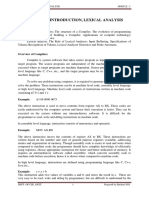Difference Between Compilers and Assembler
Uploaded by
jk716773Difference Between Compilers and Assembler
Uploaded by
jk716773Computer Organization and Assembly language
Department of CS/IT HU
Instructor: Mir Muhammad Wasiq
Difference between Compiler and Assembler
Both compilers and assemblers are the language processors used to convert software codes
written in high-level language and assembly language into machine language codes.
Why they required
Compiler and assemblers are the types of system software. These are required because a
computer cannot process a code written in high-level programming language like C, C++, Java,
etc. and assembly language. Therefore, it is necessary to convert a HLL or assembly code into
machine code for execution.
In this topic, we will highlight all the key differences between compilers and assemblers. Let's
start with some basics of compiler and assembler so that it will become easier to understand their
differences.
What is a Compiler?
Compiler is used to translate a high level programming language code to machine level
code and to create an executable program. Compiler checks the error in the program and
reports them. All errors are to be removed otherwise code will not be compiled and
executed.
A compiler takes the sources code as the input and translates it into a machine level language
code which is called object code. If there is any syntax or grammatical error in the source code,
the compiler records all these errors. A compiler can only convert a source code written in a
specific high level language. Each HLL language requires a separate compiler for translation.
Some common examples of compilers are – for Java (JDeveloper, BlueJ, etc.), for
C++ (Code Block, GCC, etc.), for Python (JPython, Spyder, etc.).
What is an Assembler?
An assembler is used to translate an assembly level code to machine readable code.
Assemblers too check the correctness of each instruction and report the diagnosis report.
In assembly language, the program is written using mnemonics (i.e. abbreviated names assigned
to binary codes). The assembler converts these mnemonics into binary code so that CPU of the
computer can understand and execute them to perform a task. Therefore, the input program to an
assembler is a source code containing mnemonics, while the output is a program containing
machine language codes.
Some common examples of assemblers are GAS, MASM, NASM, etc.
Difference between Compiler and Assembler
The following table highlights all the important difference between a Compiler and an
Assembler −
Factor Compiler Assembler
Assemblers convert the assembly
Compilers translate high level programming
Operation level language to machine level
language code to machine level code
code.
Source code in high level programming
Input Assembly level code as input.
language.
Assemblers generally do not
Conversion Compilers check and convert the complete code
convert complete code at one
type at one time.
time.
Lexical analyzer, Syntax analyzer, Semantic
Components analyzer, Code optimizer, Code generator, and Assemblers work in two passes.
Error handler
Output Mnemonic version of machine code. Binary version of machine code.
Examples C, C++ , Java compilers. GAS, GNU assemblers.
Conclusion
The most significant difference between a compiler and an assembler is that a compiler
converts a high-level language program into a machine level language program, whereas
an assembler converts an assembly language program into a machine language program.
You might also like
- Meta Trak User Guide - MetaTrak S7-S5-S5DL 01032023No ratings yetMeta Trak User Guide - MetaTrak S7-S5-S5DL 010320236 pages
- CSC411 Compiler Construction - MO Onyesolu and OU Ekwealor - First Semester 2020/2021 SessionNo ratings yetCSC411 Compiler Construction - MO Onyesolu and OU Ekwealor - First Semester 2020/2021 Session27 pages
- Automata and Compiler Design - Lecture Notes On UNIT 1No ratings yetAutomata and Compiler Design - Lecture Notes On UNIT 125 pages
- Compiler Vs Interpreter: Complete Difference Between Compiler and InterpreterNo ratings yetCompiler Vs Interpreter: Complete Difference Between Compiler and Interpreter4 pages
- Compiler Design Concepts Worked Out Examples and M100% (1)Compiler Design Concepts Worked Out Examples and M100 pages
- ACFrOgBOjR642TKzrpxTghZb9LOmbPwJgyw0-xActe0X9uw208f1MhBNW5s6lnInUEIU4Xdr_1AMchFHNf--lvXNzugMDzTo8nwfEYe6ckHry5Oi773V8HIjo5gGGQpZaHZuaFJzVTZuiO8cMkiYDg1hTQUTI_xmUWeLiH2gg6NNfvynmUkKK804NlpsCJ5PR9vt1qHQyKREJ24rnYx1No ratings yetACFrOgBOjR642TKzrpxTghZb9LOmbPwJgyw0-xActe0X9uw208f1MhBNW5s6lnInUEIU4Xdr_1AMchFHNf--lvXNzugMDzTo8nwfEYe6ckHry5Oi773V8HIjo5gGGQpZaHZuaFJzVTZuiO8cMkiYDg1hTQUTI_xmUWeLiH2gg6NNfvynmUkKK804NlpsCJ5PR9vt1qHQyKREJ24rnYx17 pages
- Compiler Design - Quick Guide: Language Processing SystemNo ratings yetCompiler Design - Quick Guide: Language Processing System51 pages
- Module-2: Introduction, Lexical Analysis: SyllabusNo ratings yetModule-2: Introduction, Lexical Analysis: Syllabus28 pages
- Ch1 IntroductiontoCompilerpdf 2023 12 18 08 57 18No ratings yetCh1 IntroductiontoCompilerpdf 2023 12 18 08 57 1871 pages
- Compiler Design BIT052 Complete Notes(RRSIMT)No ratings yetCompiler Design BIT052 Complete Notes(RRSIMT)126 pages
- Difference Between Compiler and InterpreterNo ratings yetDifference Between Compiler and Interpreter3 pages
- Chapter 1 Introduction To Compiler DesignNo ratings yetChapter 1 Introduction To Compiler Design13 pages
- Chapter 2-Introduction to Computer ProgramNo ratings yetChapter 2-Introduction to Computer Program70 pages
- COMPUTER PROGRAMMING FOR KIDS: An Easy Step-by-Step Guide For Young Programmers To Learn Coding Skills (2022 Crash Course for Newbies)From EverandCOMPUTER PROGRAMMING FOR KIDS: An Easy Step-by-Step Guide For Young Programmers To Learn Coding Skills (2022 Crash Course for Newbies)No ratings yet
- Eqexam: An Exam Construction Package: D. P. Story Email: Dpstory@uakron - Edu Processed June 17, 2021No ratings yetEqexam: An Exam Construction Package: D. P. Story Email: Dpstory@uakron - Edu Processed June 17, 2021110 pages
- 11 - AIOPS Specialist Enablement - Capstone Exercise V1.0No ratings yet11 - AIOPS Specialist Enablement - Capstone Exercise V1.014 pages
- Hacking: Don't Learn To Hack - Hack To LearnNo ratings yetHacking: Don't Learn To Hack - Hack To Learn19 pages
- Marvell AVB Switch: 7-Port Unmanaged AVB Switch With Energy Efficient EthernetNo ratings yetMarvell AVB Switch: 7-Port Unmanaged AVB Switch With Energy Efficient Ethernet2 pages
- RicohIM C2000 C2500 C3000 C3500 C4500 C5500 C6000SeriesCCGuide - ESF - v1.1No ratings yetRicohIM C2000 C2500 C3000 C3500 C4500 C5500 C6000SeriesCCGuide - ESF - v1.151 pages
- Standard Chartered Bank (Pakistan) Limited - Electronic Banking Terms and ConditionsNo ratings yetStandard Chartered Bank (Pakistan) Limited - Electronic Banking Terms and Conditions16 pages
- System design and implementation principles for industry 4 0 development of cyber physical production systems 1st Edition Luis Ribeiro - The latest ebook is available for instant download now100% (4)System design and implementation principles for industry 4 0 development of cyber physical production systems 1st Edition Luis Ribeiro - The latest ebook is available for instant download now71 pages
- Running An MPI Cluster Within A LAN MPI TutorialNo ratings yetRunning An MPI Cluster Within A LAN MPI Tutorial8 pages
- Cash2013 - Highly Scalable Searchable Symmetric Encryption With Support For Boolean QueriesNo ratings yetCash2013 - Highly Scalable Searchable Symmetric Encryption With Support For Boolean Queries21 pages
- Canonical Correlation - MATLAB Canoncorr - MathWorks IndiaNo ratings yetCanonical Correlation - MATLAB Canoncorr - MathWorks India2 pages
- Super G3 3rd 4th Line Fax Board-AE1 SM Rev0 050610No ratings yetSuper G3 3rd 4th Line Fax Board-AE1 SM Rev0 05061090 pages
- GSM System Survey: Overview of Ericsson's GSM SystemsNo ratings yetGSM System Survey: Overview of Ericsson's GSM Systems10 pages
- Hong Kong Arrow Trading Co., Limited: Proforma InvoiceNo ratings yetHong Kong Arrow Trading Co., Limited: Proforma Invoice1 page
- B.Sc. (Computer Science) SYLLABUS: Sem I S. No. Paper Code Paper NameNo ratings yetB.Sc. (Computer Science) SYLLABUS: Sem I S. No. Paper Code Paper Name11 pages

























































































